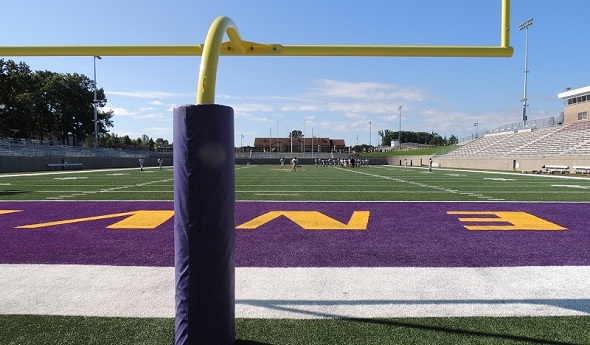
A Legacy Begins in Greenville
August 24, 2012
By Geoff Kimmerly
Second Half editor
GREENVILLE – Curtis Heppe has no idea what to expect, but a few guesses and a dream or two of how it will feel tonight to lead his teammates into Greenville's Legacy Field for the first time.
“It’s going to be electric, for sure. It’s a new vibe. It’s high-tech there,” the Yellow Jackets quarterback said Thursday after his team’s final preseason practice.
Those expectations are shared by a community that will be cheering on the local team in a new home after nearly a century at the legendary Black Field.
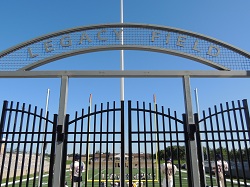 Workers put the finishing touches on the near-$7 million facility this week in advance of the season's first varsity game, tonight against rival Belding. Legacy Field officially opened for Wednesday’s freshman game, and Heppe said that even for that lower-level appetizer, the stadium began to come alive.
Workers put the finishing touches on the near-$7 million facility this week in advance of the season's first varsity game, tonight against rival Belding. Legacy Field officially opened for Wednesday’s freshman game, and Heppe said that even for that lower-level appetizer, the stadium began to come alive.
“We’ve just wanted Friday night to come. To get in and see how intense, how nice this place is,” he said. “Coming out of that tunnel, seeing our fans, it’s going to be the best feeling.”
Tonight’s grand opening will be the culmination of efforts from not just administrators, but students and community members as well – down to the name of the stadium itself.
“Legacy Field” was selected by Greenville’s school board. But it came as a suggestion from the school’s student council, which took submissions from classmates and then with faculty and administrators whittled the list to three favorites – Stinger Stadium and Community Field were next on their list.
But that’s just one way Legacy Field is a blend of old and new and ideas from all over town.
“In development, (it’s been) probably 10 years. We’ve been talking about it ever since I’ve been here, that one day we’d be able to do this,” said Greenville athletic director Brian Zdanowski, who is entering his 15th school year at that post. “It came through strategic planning. It came through community input. And then ultimately, our board bought in that there was enough interest in the community.”
Deeply rooted
A walk through Legacy Field is a history lesson. But first, an explanation of the Yellow Jackets’ past.
Black Field had served as the team’s home since 1916. It is nestled downtown next to Greenville’s former high school, which is now a library.
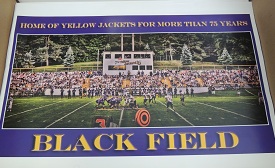 The current high school, about 1.5 miles northwest, was built in 1963. Football teams continued to make the short trip for home games.
The current high school, about 1.5 miles northwest, was built in 1963. Football teams continued to make the short trip for home games.
Black Field has its charms. With no track surrounding the field like at many multi-purpose stadiums, fans are only a few yards from the sideline. And all of that history added to the mystique for the latest players to wear the uniform.
The field also has had peculiarities. Zdanowski said at one point, the end zones were elevated in the corners. And the field wasn’t always square – a 10-yard penalty might measure 11 on one side of the field but only nine yards on the other.
But after just about every home game, students met for a bonfire on the grounds, an extension of the celebration by neighborhoods that surround Black Field and embraced the team for decades.
“It was the typical focal point of the community,” Zdanowski said.
Some things old, many new
Playing on Black Field was special, Heppe added. But he's equally if not more excited to be part of this new legacy. And architects made sure to bring that community feel to the new home this fall.
Destruction and construction began May 2, the day after last season’s final girls tennis match. The courts formerly sat in what is near the south end zone, and were moved closer to the track and soccer facility.
Amenities at the Yellow Jackets’ new football home are comparable to a college stadium’s, starting at the north side of the field.
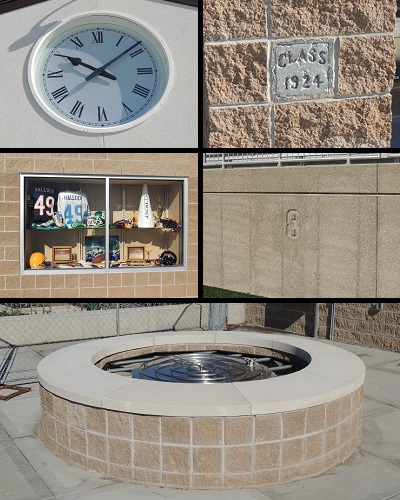 Players will enterthrough a tunnel that pours into the field like that of a miniature Spartan Stadium. Surrounding the tunnel are expansive locker rooms both for the home team and visitors, a similarly expansive training room and officials area and plenty of storage that will allow Greenville’s entire football program to be housed under that one roof. Unlike Black Field, tucked neatly among its neighbors, Legacy Field has plenty of parking and lighting, and builders were able to make that possible while also keeping intact a group of large oak trees near the south gate.
Players will enterthrough a tunnel that pours into the field like that of a miniature Spartan Stadium. Surrounding the tunnel are expansive locker rooms both for the home team and visitors, a similarly expansive training room and officials area and plenty of storage that will allow Greenville’s entire football program to be housed under that one roof. Unlike Black Field, tucked neatly among its neighbors, Legacy Field has plenty of parking and lighting, and builders were able to make that possible while also keeping intact a group of large oak trees near the south gate.
The turf is synthetic, like that played on by all but one member of the Yellow Jacket’s O-K Bronze conference. The difference from many is that the field has been dug out from the surrounding property, making it even more a focal point for those who will occupy the roughly 4,000 seats in the surrounding cement bowl. (The removed dirt was used to build two Little League fields on another part of the property.)
The sound system is of course state-of-the-art, and the press box, concessions area and restrooms also are equally expansive. But what locals should notice most are the throwbacks to the past that dot every corner of their new home.
Cut into the brick work near the concession counter is a block from Black Field that had been dedicated by the school’s class of 1924. Atop the building is the Centennial Clock, 100 years old this year, which formerly hung at the entrance the old school and was donated by the class of 1912. It has been housed by Greenville’s museum until being re-donated to the school district to become part of the stadium.
Molded into the cement walls on the west and south sides of the field are the numbers formerly worn by players Henry Loding and Greg Blumberg. Both died from football-related injuries; Loding in 1906 and Blumberg in 1977. Two trophy cases are cut into the stone on the facing of the press box, including one featuring mementos celebrating alum and former Detroit Lions tight end Ty Hallock.
Another addition of historical significance will come later. The school’s first Hall of Fame class will be inducted before the Sept. 7 game, and that display will be housed near the south ticket area so residents and fans can check it out without having the enter the stadium itself.
And one last thing was added to keep with tradition. To the west of the concession area, but within the stadium fence, sits a large gas fire pit for those postgame gatherings – plus a sound system where students can plug in their mp3 players.
“We said we’re not forgetting our past, but we’re embracing our future,” Zdanowski said. “I’m sure a lot of people have said that before. So we really wanted to make sure we got community input on it and do as much as we could to replicate Black Field. … And I think we won some people over. We really wanted to do what we said (we’d do).”
PHOTOS: (Top) Greenville's junior varsity ran through drills during a morning session at Legacy Stadium, which opened this week. (Top middle) The ticket area and gate for fans sit on the south side of the field. (Middle) A poster given out last season celebrated the final to be played at Black Field. (Bottom middle) A number of pieces of Black Field's past and Greenville tradition were brought over to or included in Legacy Field, including Centennial Clock, which formerly was part of the old school.
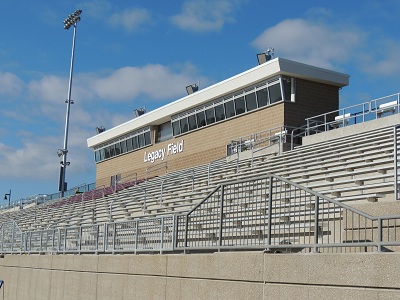
Legacy Field's press box is split into areas for game workers, coaches and media with a roll-up door for film crews.
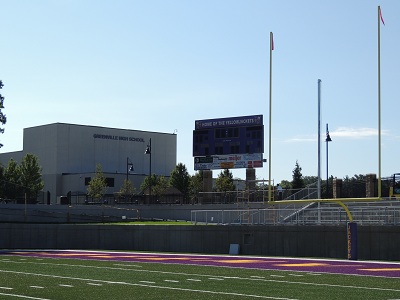
Legacy Field sits between Greenville's high school and middle school and adjacent to its soccer and track facilities.
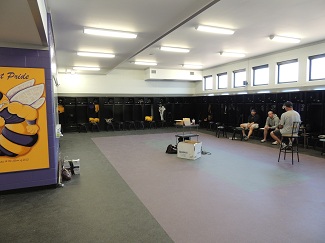
Coaches met in the spacious varsity locker room Monday morning. Junior varsity and freshman locker rooms are connected by a hallway with access to storage areas and the coaches' office.
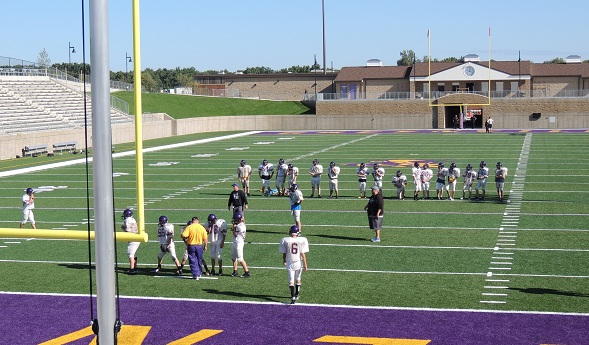 Players will enter Legacy Field through a tunnel at its north end. Above sits the concession area and restrooms, and the Centennial Clock that once ticked in the old Greenville school.
Players will enter Legacy Field through a tunnel at its north end. Above sits the concession area and restrooms, and the Centennial Clock that once ticked in the old Greenville school.
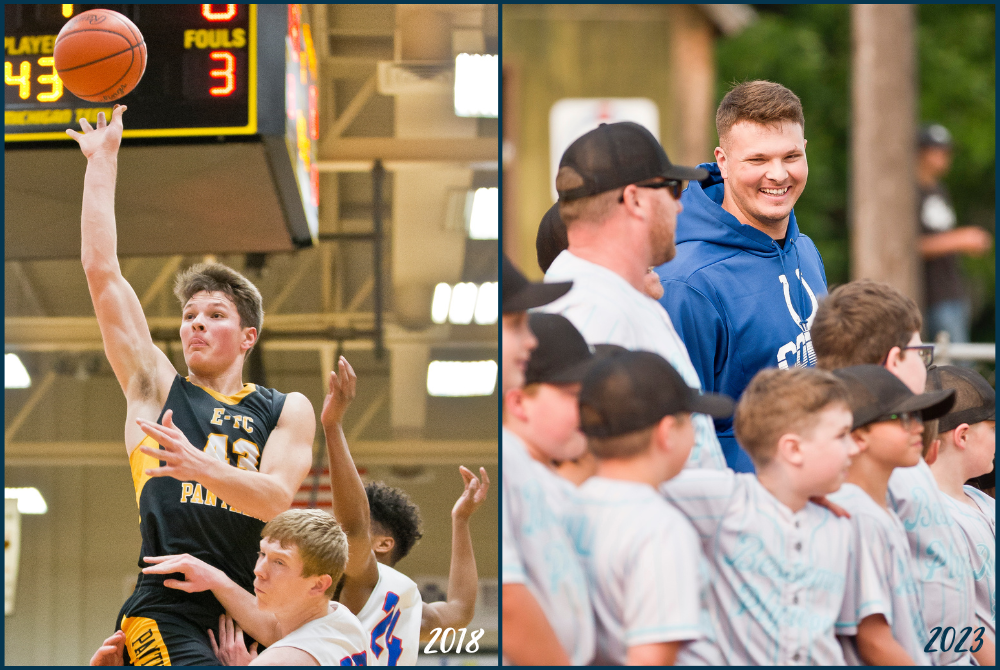
E-TC's Witt Bulldozing Path from Small Town to Football's Biggest Stage
By
Jason Juno
Special for MHSAA.com
June 28, 2024
Ewen-Trout Creek graduate Jake Witt is playing for a spot on the Indianapolis Colts’ 53-man roster. The memories of high school sports, and the impact they’ve had on his journey to the NFL, have stuck with him through his college days and even now as a professional.
 The 300-plus receiving yards he went for in a game against the eventual 8-player state champion back in 2017.
The 300-plus receiving yards he went for in a game against the eventual 8-player state champion back in 2017.
The regular-season basketball game where 3,276 fans turned out to watch his Panthers play just a few months later.
The teamwork prep sports taught him. The family atmosphere he got to be a part of on the high school football team.
“Football was definitely the sport I felt the most family-type feeling with it,” Witt said earlier this week after fishing on Erickson Lake while back in the Upper Peninsula before training camp begins next month. “That’s what drew me back to wanting to play football in college, was my opportunity in high school to play and getting that feeling with the guys and that family-oriented feel.”
Witt played two years of high school football. He lined up exclusively at wide receiver for Ewen-Trout Creek as a junior and then was more of a blocking tight end when E-TC and Ontonagon joined forces as a co-op program when he was a senior.
He ultimately decided to play basketball first in college, at Michigan Tech. But two of his three finalists were football opportunities.
“Obviously playing basketball from second grade on, people would probably assume that I would want to play basketball in college,” Witt said. “I think that just goes to show that football in those two years had a big impact and obviously it led me to where I am when I played at Northern and where I am today.”
Witt played only one year of basketball at Tech. He transferred to Northern Michigan University to attend as a student only before being talked into playing football.
He was initially a tight end there before moving to tackle because of injuries during a game against Ferris State. He dominated, not allowing a sack or even a quarterback pressure against what was considered the best Division II defensive line in the country.
He stayed at tackle for what was left of that season and then all of his final year at Northern. Despite his limited time at the position, he had the attention of NFL scouts and entered the draft. The attention reached a fever pitch during his pro day at Central Michigan when he wowed with his athleticism. His 9.92 Relative Athletic Score, a way to measure players’ athletic testing while accounting for their size, was one of the best for an offensive tackle prospect since it began being used in 1987.
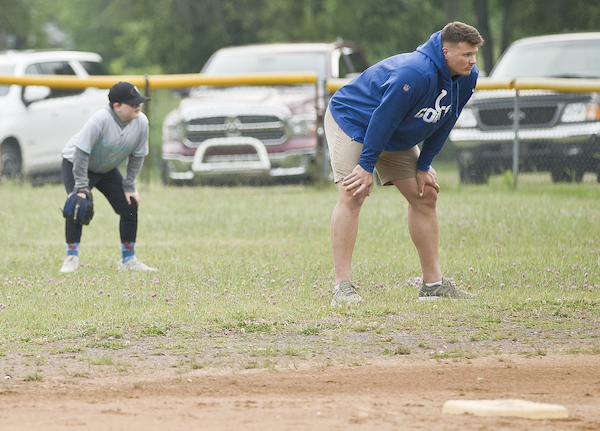 He was drafted with the 236th pick, in the seventh round, by the Colts in 2023.
He was drafted with the 236th pick, in the seventh round, by the Colts in 2023.
His first training camp was cut short due to a hip injury, and he was then placed on season-ending injured reserve. But he’s back healthy and ready to go. He practiced at second-string left tackle during the offseason camp this spring and now hopes to earn a spot on the 53-man roster with training camp set to begin in a month.
“I want to go into training camp, play well and then play well enough to where they can’t release me off the 53,” Witt said. “The next goal is to play in a game. And I think that will start with special teams, that will start with field goal. And then from there, obviously, everybody is one week of great practice away from playing with the offense, one injury away from playing in a game with the offense.”
Those who watched him during his high school days in the U.P. likely wouldn’t be at all surprised to see that happen.
Witt is still the only receiver to go for 300 or more receiving yards in 8-player football in state history, according to the MHSAA record book. And he did it twice, a 325-yard game against Eben Junction Superior Central as a junior and the 305-yard performance against Crystal Falls Forest Park as a senior.
The Ontonagon co-op team had mostly stuck to running the ball that season, but looked for Witt through the air against the eventual state champion Trojans.
“I think it was 345 (yards), I think they sent in the wrong number,” Witt said. “That was one game where we switched things up with our offensive attack and threw the ball a lot more, and it ended up paying off for us very well. We were down big at halftime, and we pushed back and we were in a battle with them in the second half. It was a great game. We didn’t end up winning, but it was a lot of fun.”
He enjoyed both years of high school football – even while mostly blocking on the line as a senior despite having shown previously to be a more-than-capable receiver.
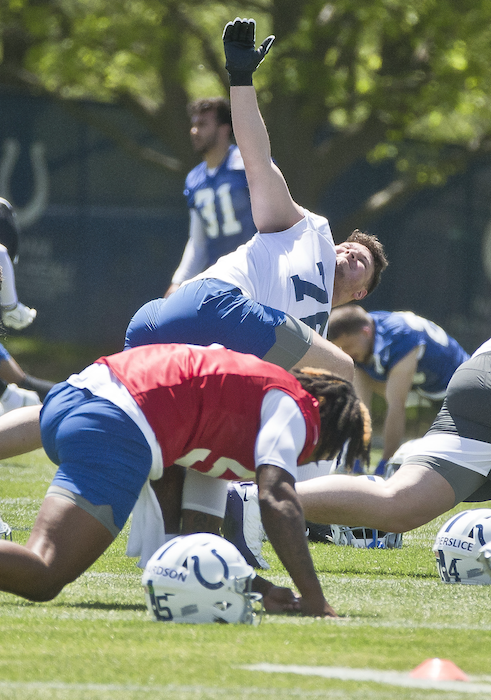 “A lot of the offense wasn’t focused on me anymore, which was great,” Witt said. “It made me a much more well-rounded football player. It made me a much better athlete, it gave me a better perception on things as a football player versus just being a receiver. I think both years were great for different reasons.”
“A lot of the offense wasn’t focused on me anymore, which was great,” Witt said. “It made me a much more well-rounded football player. It made me a much better athlete, it gave me a better perception on things as a football player versus just being a receiver. I think both years were great for different reasons.”
Witt said every sport he played in high school was beneficial to him going forward. Basketball, for example, taught him teamwork and coordination.
“And just relationship building is huge; for me, it helped me move on to the professional football level,” he said.
No high school game was quite as memorable for him as that regular-season basketball game at Michigan Tech on a chilly Wednesday night in Houghton.
Ewen-Trout Creek and Dollar Bay were tied atop the U.P. small-school poll. With that type of matchup, and the chance for fans in the Copper Country to see the 6-7 Witt and his above-the-rim play that’s pretty unique in the U.P., the game was moved from Dollar Bay’s tiny gym to Michigan Tech. (He wasn’t quite 300 pounds like he is now, but he was close – and he came into that game averaging 27 points and 16 rebounds per game with no one able to match his size and strength.)
They expected a crowd; they got 3,276. The latest arriving fans had to sit on the floor on the baseline.
“You don’t see that very much in Division 4 basketball even in the playoffs,” Witt said. “Just having that atmosphere, and especially having it between two of the best U.P. teams at the time, and having the storyline that was behind the game was great – and one of the most memorable events to this day still for me.”
Witt is looking forward to the challenge of training camp and achieving his goals in Indianapolis. But he’s not rushing away a U.P. summer.
He helped out at last week’s U.P. Football All-Star game. He was happy to provide insight for any players headed off to play college ball, and they helped the Marquette County Habitat for Humanity with the finishing touches on one of their houses.
Over the next month, he’ll still be training, going over the playbook and doing position skill work. As happy as he was to help out last week, he’s happy to be on the lake again, too, fishing like a normal Yooper.
“That’s what I’ve been trying to do, that and train,” Witt said. “Just trying to destress before I get back into it.”
PHOTOS (Top) At left, Jake Witt played for Ewen-Trout Creek during a 2018 basketball game at Michigan Tech, and at right Witt takes a photo with area youth baseball players last summer. (Middle) Witt, right, umpires a baseball game last summer. (Below) Witt warms up during the Indianapolis Colts’ rookie camp in May 2023. (Photos by Jason Juno.)

